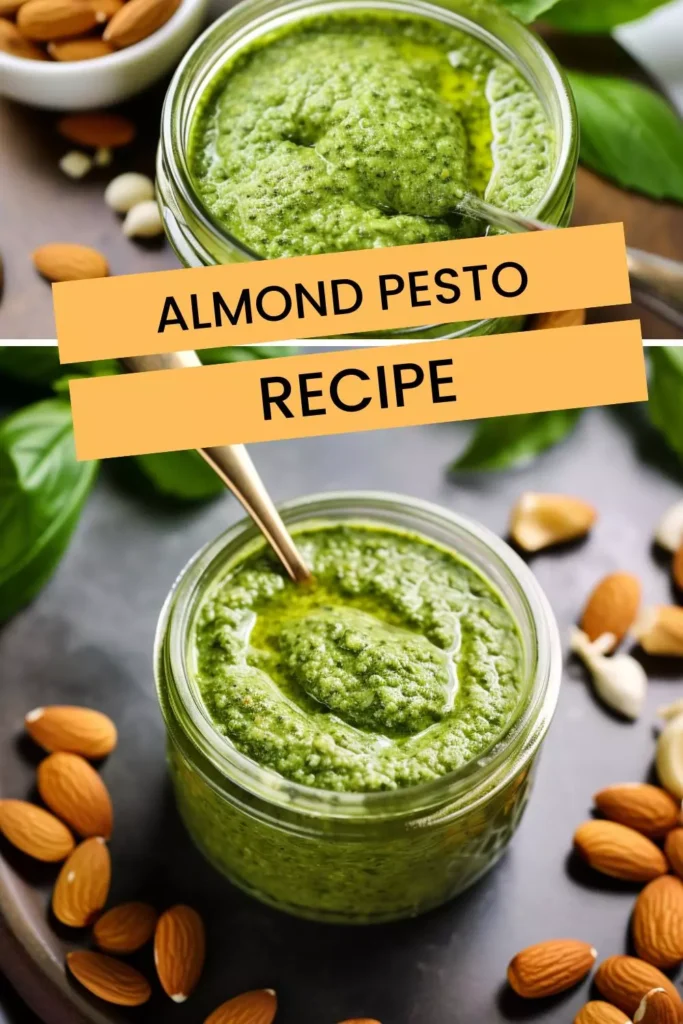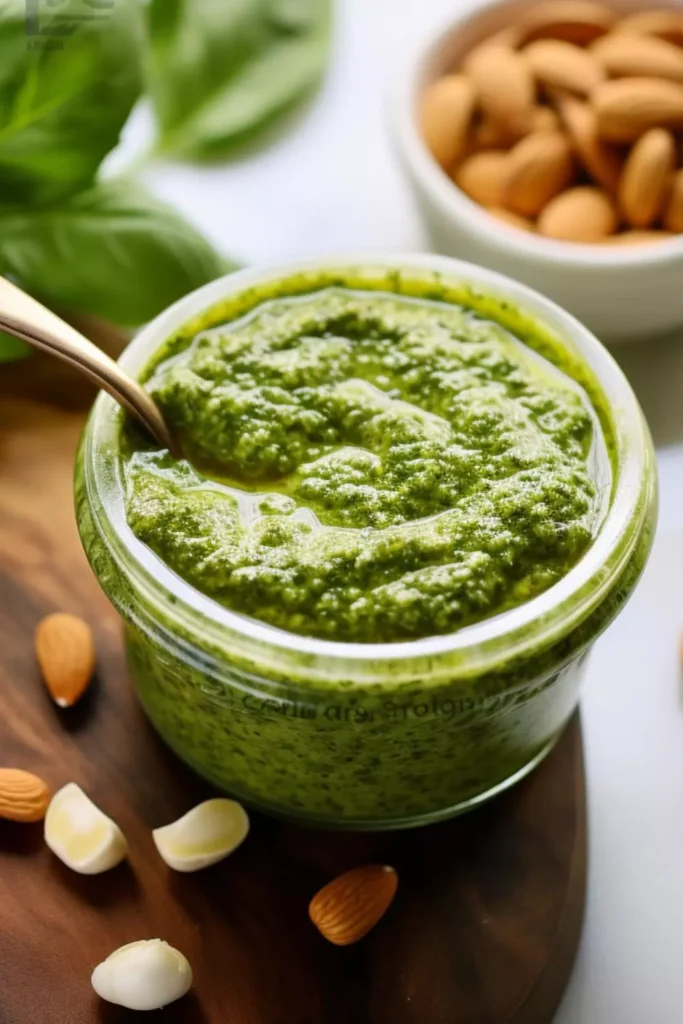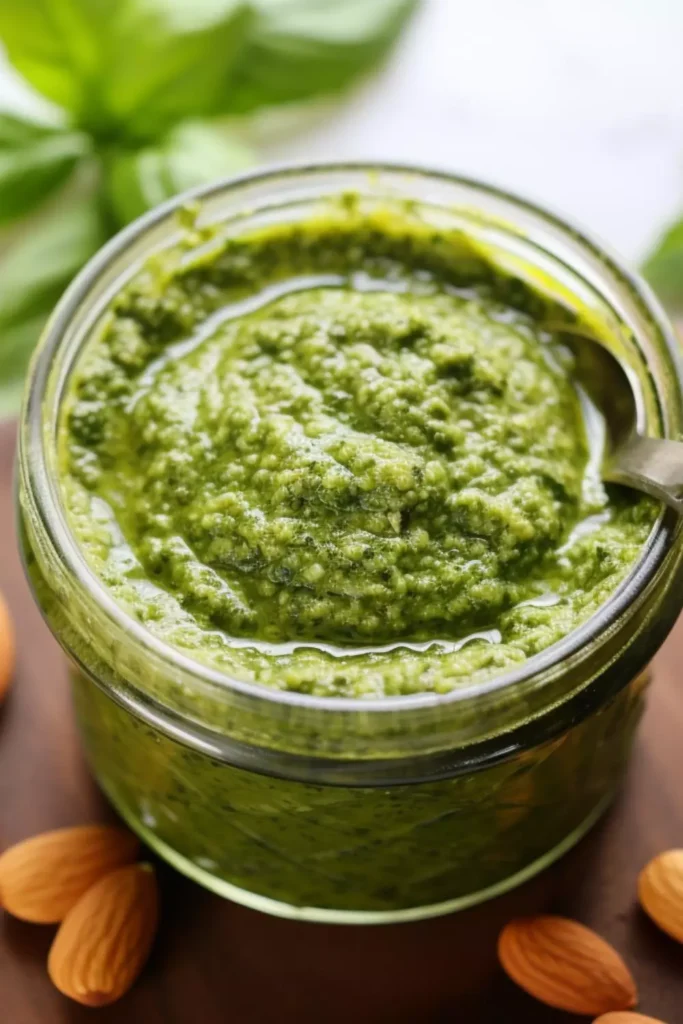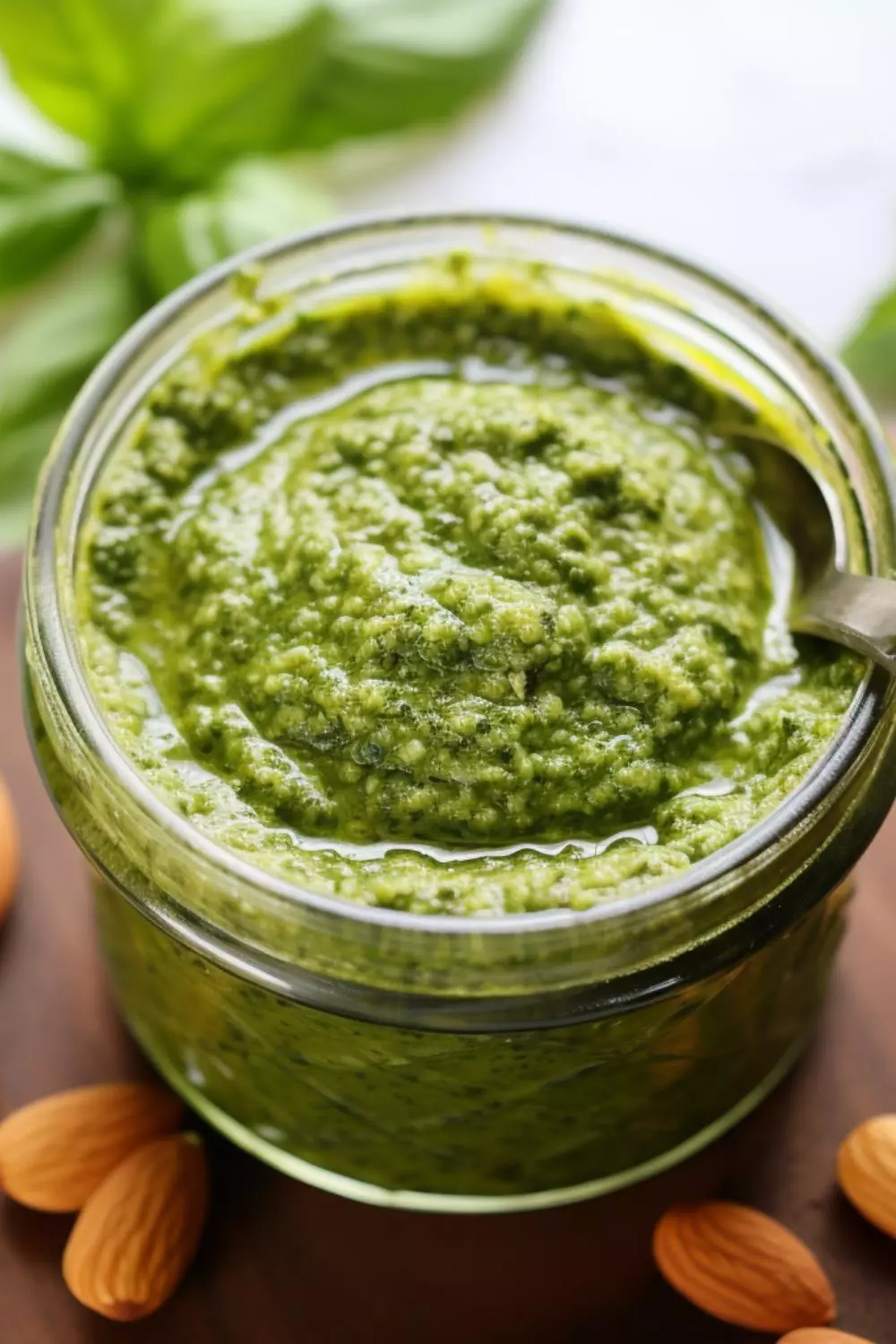Almond pesto is a delightful twist on the classic Italian sauce that’s traditionally made with pine nuts. This rich and aromatic condiment combines the fresh, vibrant flavors of basil with the crunchy, nutty goodness of almonds. The recipe also includes ingredients such as garlic, Parmesan cheese, and extra-virgin olive oil, resulting in a versatile sauce that adds a burst of flavor to a variety of dishes.
Whether you’re tossing it through pasta, spreading it on pizza, or using it as a dip, this almond pesto recipe is easy to make and sure to impress. Get ready to explore the delicious possibilities of this delightful fusion of flavors.

What is almond pesto?
Almond pesto is a sauce made by blending almonds, basil, garlic, Parmesan cheese, and olive oil. It is similar to the more traditional pine nut-based pesto sauce, but with a unique twist that adds depth and complexity to the dish. This delicious condiment originated in Italy but has gained popularity all over the world due to its versatile nature and delicious taste.
Why You’ll Love this almond pesto?
There are many reasons to love almond pesto. First and foremost, it is incredibly flavorful and adds a burst of freshness to any dish. The combination of herbs, nuts, and cheese creates a perfect balance of flavors that will tantalize your taste buds. Moreover, almond pesto is very easy to make, requiring just a few simple ingredients and minimal preparation time.
This makes it a perfect go-to option for busy weeknights or last-minute dinner parties. Another reason to love almond pesto is its versatility. While traditionally used as a pasta sauce, it can also be used as a spread, dip, or marinade for meats and vegetables. Its creamy texture and rich taste make it a great addition to many different dishes.
You’ll also like the following Dinner recipes!
Ingredients
- Fresh Basil Leaves: The star of the show, basil brings a unique flavor that is both sweet and savory, with notes of mint, anise, and clove. It’s the primary ingredient in many Italian dishes, including pesto. The freshness of the leaves contributes to the vibrant color and bold flavor of the dish.
- Garlic Cloves: Garlic is a cornerstone of flavor in countless recipes. It brings a strong, pungent aroma and taste that can transform a dish. In this recipe, it adds a depth of flavor and complements the freshness of the basil.
- Toasted Almonds: Toasted almonds add a delightful crunch to the recipe, providing texture contrast. Their rich nutty flavor also complements the other ingredients, adding depth and complexity to the overall flavor profile of the dish.
- Grated Pecorino Cheese: Pecorino is a hard, salty Italian cheese, made out of sheep’s milk. It adds a sharp, tangy flavor to the dish. The cheese also helps to bind the other ingredients together, creating a smoother texture for the pesto.
- Kosher Salt or Fine Salt: Salt enhances the flavors of all the other ingredients. It helps to draw out the natural flavors of the basil, garlic, and almonds, while also balancing the richness of the pecorino cheese.
- Extra Virgin Olive Oil: Olive oil acts as a liquid base for the pesto, helping to blend the ingredients into a cohesive sauce. The oil also carries the flavors of the other ingredients, allowing them to meld together. The ‘extra virgin’ classification means it’s less processed and retains a more true olive taste, which adds a fruity note to the dish.

Directions
Step 1: Toast the Almonds
Begin by toasting the almonds in a dry pan over medium heat. Continue toasting them until they turn a beautiful golden brown and emit a fragrant, nutty aroma. This toasting process enhances the flavor and aroma of the almonds.
Step 2: Process the Almond Base
In a food processor, combine the toasted almonds, garlic cloves, and grated Pecorino cheese. Pulse the ingredients until they are finely chopped and well integrated. This forms the flavorful base of your pesto.
Step 3: Add Fresh Basil and Olive Oil
Introduce the fresh basil leaves into the food processor along with the almond mixture. While the processor is running, drizzle in the extra virgin olive oil gradually. Continue processing until all the ingredients come together, resulting in a smooth and well-combined pesto sauce. This step infuses the pesto with its signature vibrant green color and fresh basil flavor.
Step 4: Adjust Consistency
If the pesto appears too thick for your liking, you can add more extra virgin olive oil to achieve your desired texture. This allows you to customize the pesto’s consistency to suit your preference.
Step 5: Season to Taste
Taste the pesto and adjust the seasoning with salt as needed. This step ensures that your pesto is perfectly balanced in terms of flavor. Add salt gradually and taste after each addition to avoid over-salting.
Notes
- To make a vegan version of almond pesto, simply omit the cheese or substitute it with a vegan alternative.
- For a creamier texture, you can also add a small amount of heavy cream or Greek yogurt to the pesto while blending.
- It’s delicious as a spread on sandwiches, a dip for vegetables or crackers, or even as a marinade for chicken or fish.
- Experiment with different herbs and nuts to create your unique twist on almond pesto. Try adding in some parsley, cilantro, or walnuts for a different flavor profile.
- Don’t shy away from using the pesto as a finishing touch for soups, salads, or roasted vegetables. It adds a burst of freshness and flavor to any dish.
Storage Tips
To store almond pesto, transfer it into an airtight container or jar and refrigerate for up to 1 week. If you want to keep it for longer, you can freeze it in ice cube trays and then transfer the frozen cubes to a freezer-safe bag. When ready to use, simply thaw out as many cubes as needed.

Nutrition Information
Serving Suggestions
- As a Pasta Sauce: Toss your favorite pasta with almond pesto for a quick and easy dinner option. Top it off with some grated Pecorino cheese for added flavor.
- As a Pizza Topping: Use almond pesto as an alternative to tomato sauce on your next homemade pizza. It pairs well with toppings like grilled chicken, artichokes, and roasted red peppers.
- As a Dip: Serve almond pesto as a dip for vegetables, crackers, or bread. It’s perfect for parties or as a snack any time of the day.
- As a Marinade: Use almond pesto to marinate meats like chicken, fish, or shrimp before grilling or roasting. The nutty flavor adds depth and complexity to the dish.
- As a Sandwich Spread: Give your sandwiches a delicious twist by using almond pesto as a spread. It pairs well with deli meats, grilled vegetables, or even avocado for a vegetarian option.
What other substitute can I use in almond pesto?
If you have a nut allergy or simply want to change up the flavor, there are a few substitutes you can use in almond pesto. Some options include:
- Pumpkin seeds: Toasted pumpkin seeds can be used as a substitute for almonds in pesto. They provide a similar crunch and nutty flavor.
- Sunflower seeds: Another nut-free option, sunflower seeds can be used in place of almonds. They add a nice crunch and slightly different flavor to the pesto.
- Pine nuts: For a more traditional pesto flavor, you can use pine nuts instead of almonds. They have a buttery taste and lend a creamy texture to the sauce.
- Breadcrumbs: In a pinch, breadcrumbs can be used as a substitute for nuts in pesto. They help to thicken the sauce and add some texture, but won’t provide the same nutty flavor.
- Other herbs: While basil is the traditional herb used in pesto, you can experiment with other herbs like parsley, cilantro, or even spinach for a different flavor profile.

Equipment
- Pan
Ingredients
- 4 ounces grated pecorino cheese
- 2 cloves of garlic
- 1 cup extra-virgin olive oil
- 4 cups fresh basil leaves packed approximately 3 ounces
- 2 tsp kosher salt or 1 tsp fine salt
- ⅔ cup toasted almonds
Instructions
- Begin by toasting the almonds in a dry pan until they turn golden brown and fragrant.
- In a food processor, combine the toasted almonds, garlic cloves, and grated Pecorino cheese. Pulse until finely chopped.
- Add fresh basil leaves and continue to pulse while drizzling in extra virgin olive oil until everything reaches a smooth consistency.
- Adjust the pesto’s thickness by adding more olive oil if necessary.
- Taste and season with salt as needed to achieve the desired flavor. Enjoy your homemade pesto!
Notes
- To make a vegan version of almond pesto, simply omit the cheese or substitute it with a vegan alternative.
- For a creamier texture, you can also add a small amount of heavy cream or Greek yogurt to the pesto while blending.
- It’s delicious as a spread on sandwiches, a dip for vegetables or crackers, or even as a marinade for chicken or fish.
- Experiment with different herbs and nuts to create your unique twist on almond pesto. Try adding in some parsley, cilantro, or walnuts for a different flavor profile.
- Don’t shy away from using the pesto as a finishing touch for soups, salads, or roasted vegetables. It adds a burst of freshness and flavor to any dish.
Nutrition
FAQs
Q: Can I use a different type of cheese in almond pesto?
A: Absolutely! While Pecorino adds a sharp, tangy flavor to the pesto, you can also use other hard cheeses like Parmesan or Asiago. Feel free to experiment with different types of cheese and find your favorite combination.
Q: Can I use an almond meal instead of whole almonds?
A: Yes, you can use almond meal or almond flour in place of whole almonds. This will save you the step of toasting and chopping the almonds but may result in a slightly different texture. Still delicious though!
Q: Can I use dried herbs instead of fresh?
A: While fresh herbs provide the best flavor for pesto, you can substitute with dried herbs if needed. Use 1/3 of the amount called for in the recipe, as dried herbs are more concentrated in flavor. For example, if the recipe calls for 1 cup of fresh basil leaves, use 1/3 cup of dried basil.
Q: Is almond pesto gluten-free?
A: Yes, almond pesto is naturally gluten-free. Just be sure to double-check any packaged ingredients for the gluten-free label. Also, if used as a dip or spread, pair with gluten-free crackers or bread.
Q: Can I use roasted almonds instead of toast?
A: Yes, you can use either toasted or roasted almonds for pesto. However, keep in mind that roasted almonds may add a slightly different flavor to the pesto due to the added salt and oil used in roasting. Adjust seasoning with salt accordingly.
Conclusion
Almond pesto is an excellent addition to anyone’s cooking repertoire. Its versatility, simplicity, and delicious flavors make it a go-to sauce for many occasions. Whether you’re looking to add some excitement to your weeknight dinners or impress guests at a dinner party, this recipe is sure to elevate any dish it’s added to.
Get creative and have fun exploring the endless possibilities of almond pesto! So next time you’re craving a taste of Italy, try making this easy almond pesto at home and bring a burst of flavor to your meals. Happy cooking!
You’ll also like these latest recipes!
Lori Walker is a passionate dietitian and food lover. She offers simple and nutritious recipes that don't take long to cook. In addition to sharing delicious dishes, she also shares useful advice on saving time and money in the kitchen. She believes that with a bit of creativity, anyone can make healthy meals that won't break the bank. Read more
